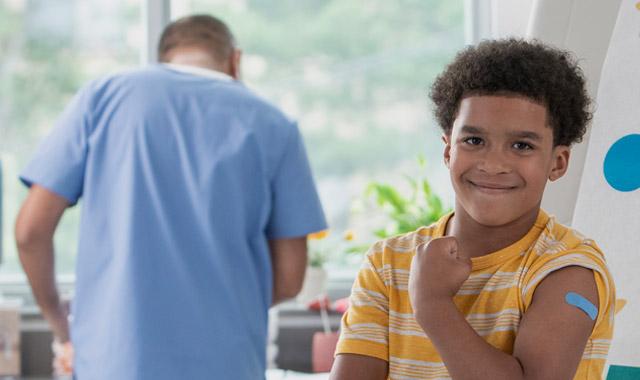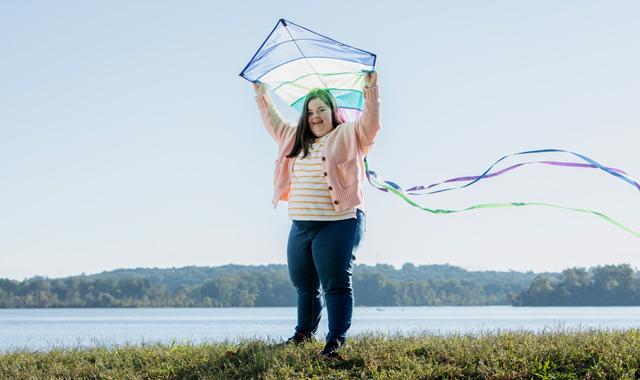Learn about the amazing safety net that ensures vaccines are safe.
Vaccines are one of the greatest success stories in public health.source: 1 Decades of research are the foundation for today’s vaccines, which go through clinical trials and a thorough evaluation by scientific and medical experts at the U.S. Food and Drug Administration (FDA) before they are approved. And they are continuously monitored after they are approved for as long as they are on the market.source: 2,source: 3 Learn the rigorous process vaccines goes through to make sure they work and are safe so you can be confident that vaccines help protect your children.
Exploration
Lab testing
Once scientists find the right antigen, they test the potential vaccine to make sure it works safely. Long before anything is tested with volunteers, vaccines are tested in the lab with tissue or cell samples and animal testing. That’s why this step is called the Pre-Clinical Stage.source: 3 The results help scientists understand what responses may occur in humans. They also help us know if is safe to move forward with testing in people.source: 3
Clinical trials
Next, vaccines go through clinical trials. There are three main stages of clinical trials, each looking at specific things and studying them in different numbers of people.source: 2,source: 3,source: 6
| Phase specifications | Phase 1 | Phase 2 | Phase 3 |
|---|---|---|---|
| Number of Volunteers | Small: 20 – 100 people | Medium: Several hundred people | Large: Thousands of people |
| Focus | Safety |
|
|
| Questions Answered in Most Clinical Trials |
|
|
|
Depending on the type of study some stages can be combined, so you may see a Phase 2/3 study. Additionally, studies typically include a control group consisting of people who may receive an FDA-approved vaccine, a placebo, or another substance. There is also sometimes a Phase 4 study that takes place after the FDA approves a vaccine. These studies may be required by the FDA to further look at known or potential serious risks.source: 2,source: 3
Vaccines for children are generally tested using a step-down approach.source: 3 This means clinical trials generally begin with adults first and then step down in age to teens, then children, then babies.source: 6 Clinical trials for children generally focus on finding the right dosage that will give children of all ages the best protection with the fewest side effects.
FDA approval
Once the clinical trials are complete, the FDA’s medical and scientific experts review the data to make sure the vaccine is safe, effective, and the benefits outweigh the risks. The FDA also evaluates information about the manufacturing of the product to make sure it can be made consistently and is high quality. After this evaluation of the clinical and manufacturing information, the FDA decides whether to approve the vaccine for use.source: 3
Review by external experts
If the FDA approves the vaccine, a group of external experts called the Advisory Committee on Immunization Practices (ACIP) reviews the clinical trial data. They decide whether or not to recommend that the vaccine be included on the recommended immunization schedule. If ACIP does make this recommendation, the Centers for Diseases Control and Prevention (CDC) director does a final review and approves or denies the recommendation.source: 7

Monitoring
The United States has one of the strongest vaccine safety nets in the world. Before a vaccine even leaves a manufacturing plant, monitoring has begun:
- Facility Monitoring: The FDA inspects all vaccine manufacturing sites regularly to make sure quality and safety standards are met.source: 3
- Batch Testing: Vaccines are made in large batches called lots. Every single lot of vaccines is tested by the manufacturer to make sure the vaccine is made consistently. Samples are also submitted by the manufacturer to the FDA to confirm the manufacturer's results. For approved vaccines, no lot can be distributed until the FDA releases it.source: 3
Once the vaccine lots have been released by the FDA, monitoring begins. There are a number of vaccine safety monitoring systems. Each has a slightly different role, but together they create an incredibly strong safety net. Some of the key monitoring systems are:
- Vaccine Adverse Events Reporting System (VAERS): VAERS is a reporting system for adverse events following vaccination. Anyone can make a report to VAERS, and those reports are publicly available for anyone to read. Experts review the reports to see whether there is a potential pattern. If they find one, they investigate to determine whether an adverse event is related to a vaccine. It’s important to remember that the reports are not proof of a vaccine adverse event. Experts must examine the issue to determine if the adverse event was related to a vaccine. Learn more about VAERS.
- Vaccine Safety Datalink (VSD): VSD is a network of health care systems that investigate and research vaccine safety. They do this by anonymously monitoring every person in their system who has received a vaccine to see if any reported side effects are related to vaccines. They also investigate any patterns found in VAERS to see whether they are connected to vaccines.
- Clinical Immunization Safety Assessment (CISA) Project: CISA is a network of vaccine safety experts, medical research centers, and other public health and medical partners. CISA gives health care providers answers to complex vaccine safety questions and conducts clinical research to evaluate vaccine safety.
- Biologics Effectiveness and Safety (BEST) System: BEST is a system that uses multiple high quality data sources to evaluate the safety and effectiveness of vaccines and other biological products.
In addition to these overarching safety systems, there are other more specific safety systems including:
Finally, there is also ongoing vaccine safety research.source: 8
Quiz: How well do you know the risks?
Question 1 of 5: Why do we still need to vaccinate for whooping cough?
Correct
Yes! All the answers are correct. Whooping cough can be very serious for babies.
Incorrect
Actually, all the answers are correct. Whooping cough can be very serious for babies.
Thanks to most kids getting whooping cough vaccines, cases of the disease have decreased more than 75%. And getting vaccinated while pregnant passes protection to the baby. This helps protect the baby before they’re old enough to get their own vaccine.
Question 2 of 5: If one person has measles, how contagious is it in people who are not immune?
Correct
Correct! Measles is one of the most contagious diseases in the world. If 1 person has it, 9 out of 10 people close to that person will also get measles if they aren't protected.
Incorrect
No, measles is one of the most contagious diseases in the world. If 1 person has it, 9 out of 10 people close to that person will also get measles if they aren't protected.
Measles can live in the air for up to 2 hours after an infected person leaves an area. It can be a very serious disease:
- 1 in 5 unvaccinated people who get measles will be hospitalized
- 1 in 20 unvaccinated children who get measles will get pneumonia
- Unvaccinated pregnant women who get measles may have a premature or low birth weight baby
Question 3 of 5: How many childhood deaths have routine vaccines prevented?
Correct
Very good!
Incorrect
No, vaccines have saved many more children!
Vaccines are expected to prevent more than 1 million deaths among children in the United States who were born between 1994 and 2023. That’s more than the entire population of Denver, Colorado.
Question 4 of 5: What diseases have vaccines wiped from the face of the earth?
Correct
Yes! Before a vaccine was used to eradicate smallpox, 3 out of 10 people who had it died.
Incorrect
Good try, but only smallpox has been wiped from the face of the earth. Before a vaccine was used to eradicate smallpox, 3 out of 10 people who had it died.
But we are also very close to eradicating polio. Polio paralyzed almost 21,000 people in the U.S. in 1952 alone. Polio is rare in the United States, but it still exists in a few countries in Asia and Africa. Remember, we still need to vaccinate until polio is gone everywhere, because viruses, just like people, travel.
Question 5 of 5: What are the risks of serious side effects happening after vaccination?
Correct
Yes! Generally, only 1–2 vaccine doses in 1 million will result in a severe allergic reaction.
Incorrect
No, the risk is much, much smaller. Generally, only 1–2 vaccine doses in 1 million will result in a severe allergic reaction.
To put that in perspective, you have a 1 in 15,300 chance of being struck by lightning in your lifetime and a 1 in 46,744 chance of dying from a hornet, wasp, or bee sting—both much more likely than having a severe allergic reaction from a vaccine.
It’s important to understand the true risk of something to make an informed decision.
Thanks for participating.
Want to brush up on your knowledge?
Browse this site to learn more.
You scored

Share the facts
Spreading the truth saves lives, so use our resources to help parents understand how vaccines work, why they’re safe, and how they help protect kids.
Vaccine science
The science behind vaccines helps us understand how they work and why they are effective.
Vaccine-preventable diseases
Routine childhood vaccines help prevent the spread of illnesses that once killed or harmed many infants, children, and adults.source: 9,source: 10,source: 11
Vaccine schedule
Sticking to the vaccine schedule helps protect your child against more than a dozen diseases.source: 12,source: 13
Sources
- CDC: How Vaccine Safety Monitoring Works
- CDC: How Vaccines are Developed and Approved for Use
- FDA: Vaccine Development – 101
- UChicago Medicine: How are vaccines made?
- MedlinePlus: Antigen
- Journal of Postgraduate Medicine: The clinical development process for a novel preventive vaccine: An overview
- CDC: Role of the Advisory Committee on Immunization Practices in CDC’s Vaccine Recommendations
- CDC: Vaccine Safety Systems
- American Academy of Pediatrics: 14 Diseases You Almost Forgot About Thanks to Vaccines
- HHS: Five Important Reasons to Vaccinate Your Child
- FDA: Vaccines Protect Children From Harmful Infectious Diseases
- CDC: Child and Adolescent Immunization Schedule by Age
- CDC: Reasons to Follow CDC’s Recommended Immunization Schedule


